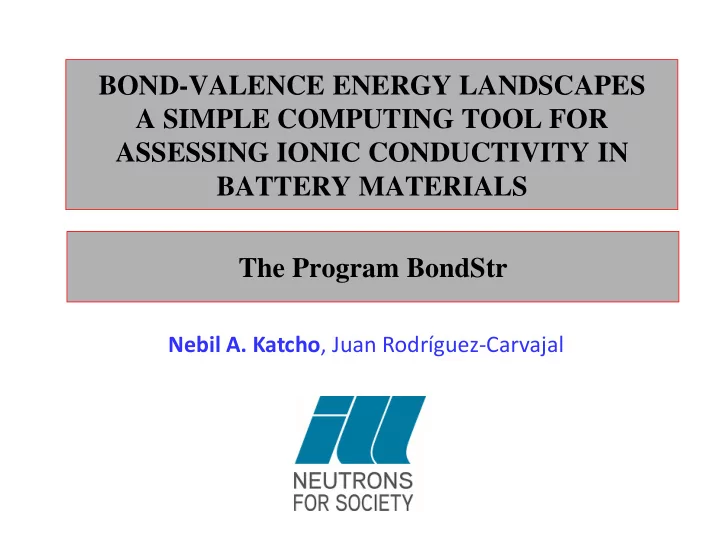

BOND-VALENCE ENERGY LANDSCAPES A SIMPLE COMPUTING TOOL FOR ASSESSING IONIC CONDUCTIVITY IN BATTERY MATERIALS The Program BondStr Nebil A. Katcho , Juan Rodríguez-Carvajal
Basics of bond-valence theory • The bond-valence method is a development of the Pauling rules • Each bond A-X has a valence s A-X , which depends on bond length, chemical nature of the elements and oxidation states R R exp 0 A X s A X b R 0 and b ( 0.37Å) are tabulated parameters characteristic of the pair A-X and R A-X is the bond length • Valence sum rule : The total valence V A of the cation A (ideally equal to the magnitude of the formal charge) coordinated by N C anions X is given by the bond-valence sum (BVS): N C ( ) ideal V s V formal charge A A X A i 1 i http://www.iucr.org/resources/data/data-sets/bond-valence-parameters I. D. Brown, The Chemical Bond in Inorganic Chemistry: The Bond Valence Model , Oxford University Press, 2002.
Validation of crystal structures The bond valence approach is frequently used to validate newly • determined crystal structures by the calculation of the Global Instability Index (GII) N 1 asym N cell : total number of atoms in the unit cell 2 2 ( ) ideal GII m BVS V N asym : number of atoms in the asymmetric unit i i i N m i : multiplicity of the site i . 1 i cell An example: LiB 3 O 5 Formal Bond Bond Atom oxidation valence valence state sum mismatch Li +1 +0.856 +0.144 B +3 +3.011 -0.011 O -2 -1.978 -0.022
Ionic conduction and the BV method The bond-valence method can be used for assessing the ionic • conduction path from the knowledge of the crystal structure. • Low-energy transport pathways for the motion of ions between equilibrium sites should correspond to a sequence of positions for which the BVS mismatch: V(r)=|BVS(r)- V ideal (r)| remain as small as possible , so a simple geometric calculation allows to figure out possible ionic conduction paths.
Examples of the BVS isosurfaces Differential bond-valence mismatch in Ag-I Bond valence isosurface Bond valence isosurface for -AgI ( V=0.05 val. un.) for -AgI ( V=0.083 val. un.) S. Adams, J. Swenson, Phys. Rev. B 63 (2000) 054201
Examples of the BVS isosurfaces Differential bond-valence mismatch in Li 2 B 4 O 7 MEM reconstruction of negative Differential valence map of lithium (Li) nuclear scattering densities in Li 2 B 4 O 7 ( V=0.2 val. un.) in Li 2 B 4 O 7
Ionic conduction and the BV method • Limitation of the conventional BVS method: Only the first coordination shell is considered. No energy units are available to compare between different compounds Trick: Use simple parameters for converting BV expression to an adequate potential (including Coulomb repulsive terms) and extend the action distance allowing to get more precise results
Ionic conduction and the BV method
Extension of the BVS method • Not only first coordination shell but a sphere with cutoff radius R cut is considered; • both R 0 and b parameters are adapted using bond-stifness approach; Pseudopotential representation of the correlation between bond-length R and Typical Morse potential bond valence s. S. Adams, Acta Cryst. B 57 (2001) 278
Extension of the BVS method Stefan Adams, Practical Considerations in Determining Bond-Valence Parameters , Structure and Bonding 158 , 91-128 (2014)
Extension of the BVS method Energy isosurfaces of LiFePO 4 E-E min = 0.91 eV E-E min = 0.80 eV E-E min = 0.20 eV
Examples of the BVEL isosurfaces Cathodes for Li-ion batteries 1D 2D 3D Li x CoO 2 Li x FePO 4 LiMn 2 O 4 olivine distorted rock-salt spinel
Examples of the BVEL isosurfaces BVEL DFT
Computer programs The program needs the use of Materials Studio
The BondStr program Features: BV and BVEL maps Map visualization with VESTA Automatic assignation of formal charges Automatic detection of percolation energy High-throughput calculations Distributed within the FullProf suite
The BondStr program: the output
The BondStr program: the output
Screening the ICSD with BondStr • We have used BondStr to investigate the crystal structure – ion conductivity relation in Li and Na compounds Number of compounds Percolation energy (eV) Li Percolation energy (eV) Number of compounds Percolation energy (eV) Na Percolation energy (eV)
Summary • Bond-Valence Energy maps/isosurfaces give a clear evidence (first approximation) for the ionic diffusion pathways in the material • BVEL Model has a high predictive potential and is adapted for studying whatever ionic diffusion species - the cation conductors, e.g. sodium or magnesium - the anion conductors, e.g. oxygen or hydrogen … - This model is now used to predict percolation energies and conduction paths systematically on databases (i.e. ICSD) • The BVEL Model is restricted to compounds close to ionic character; e.g. it does not, in general, apply to metals or organic compounds • The program Bond_Str together with a GUI is distributed within the FullProf Suite . The source code is freely available within the repository of the CrysFML library: https://forge.epn-campus.eu/projects/crysfml/repository
Recommend
More recommend